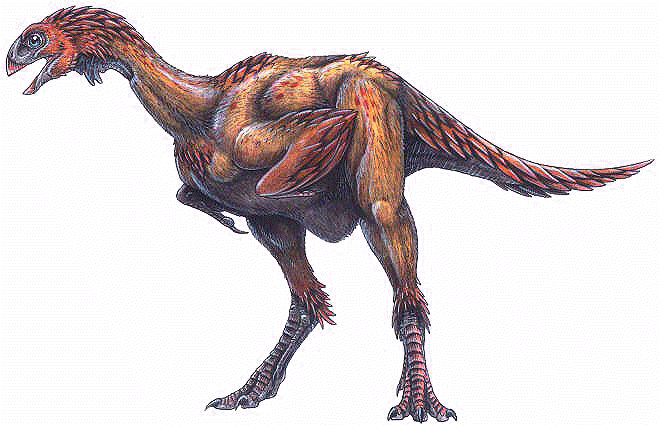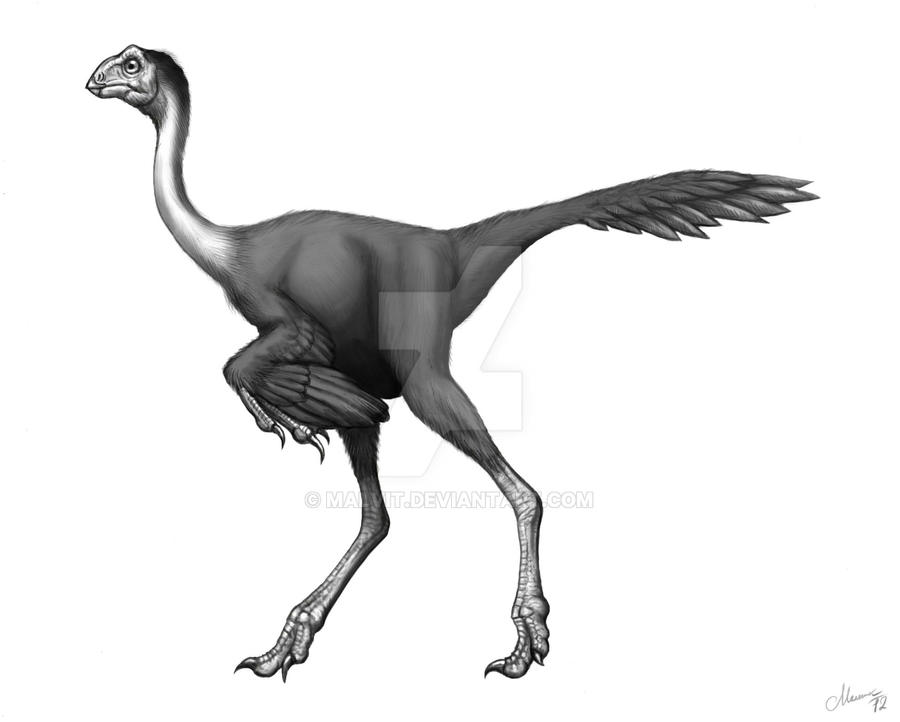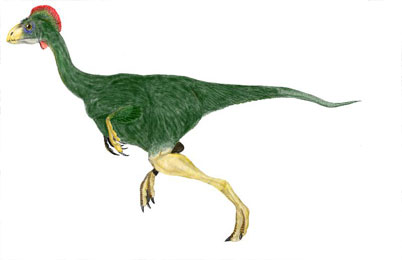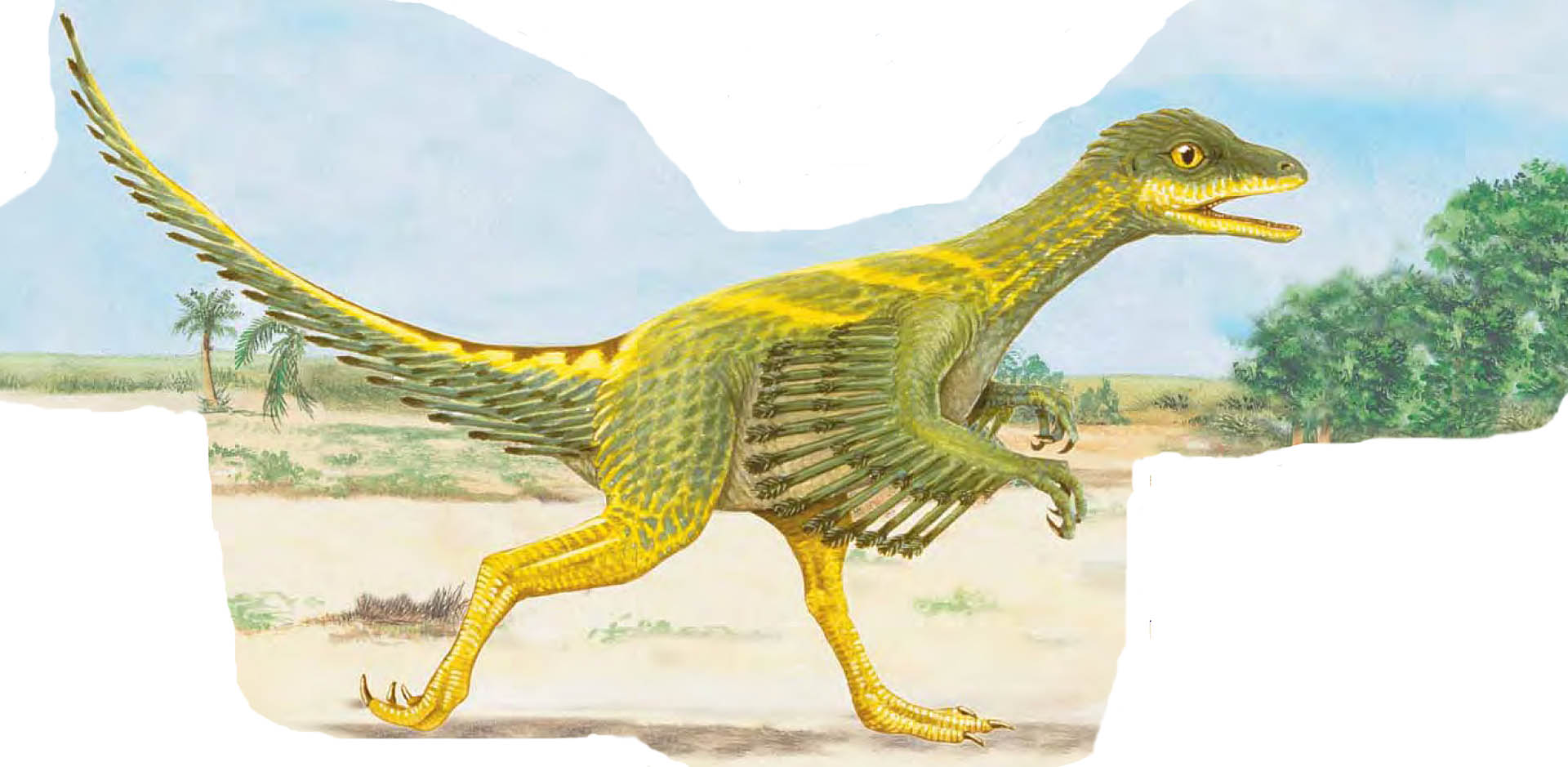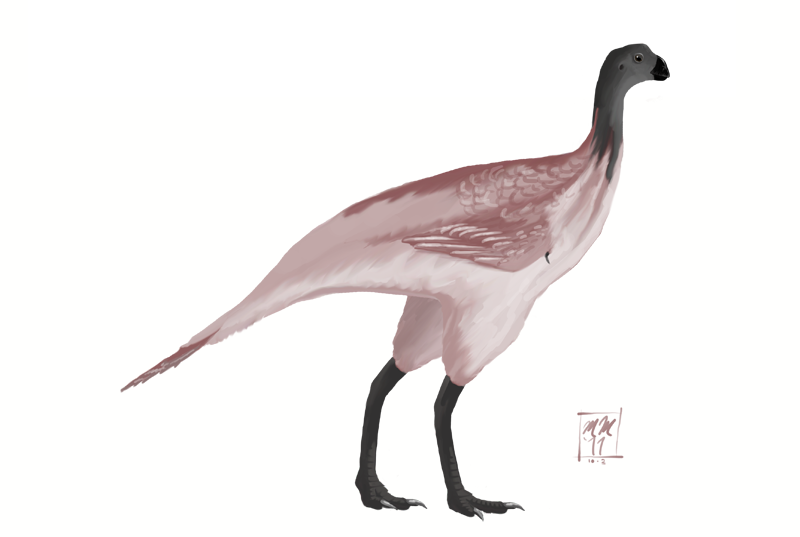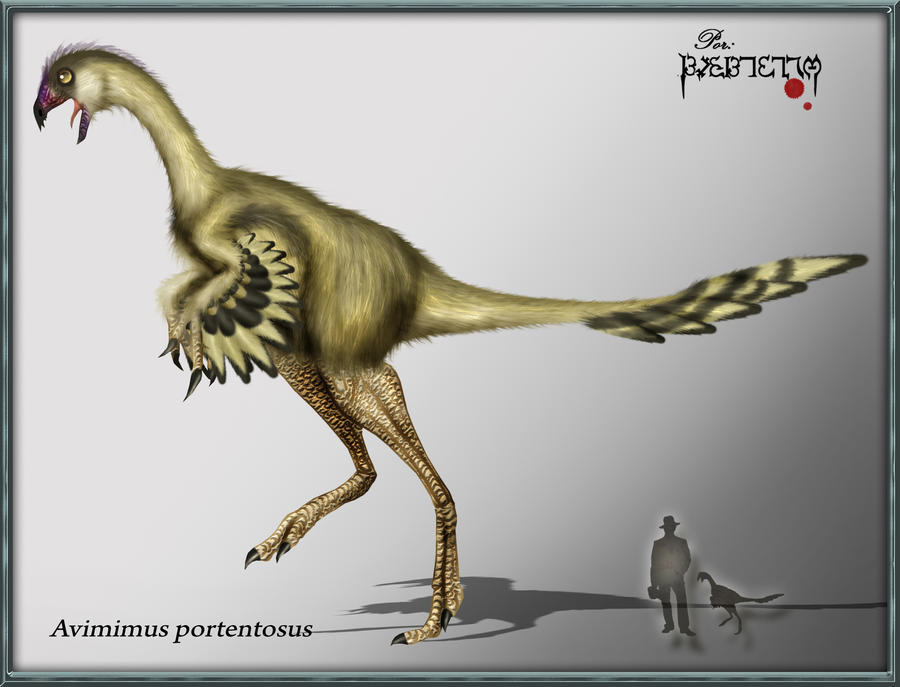Avimimus
Graphical representation of live Avimimus
- Mongolia, possibly China
- Avimimus portentosus
- Avimimus sp. Ryan, Currie & Russell, 2001
Avimimus was a theropod dinosaur from the group of Oviraptorosauria from the Upper Cretaceous of East Asia.
This genus was first described in 1981 by Sergei Kursanow with the way Avimimus portentosus, based on a nearly complete skeleton.
Another nearly complete skeleton was discovered in 1996. In 2001, a second type Avimimus sp. described based on a few isolated bone. In 2008, the discovery of a bonebeds ( bone stock ) was introduced, which contains the remains of at least 10 Avimimus individuals.
Avimimus was about 1.5 meters long, bipedal running theropod, whose jaws formed a largely toothless beak - this could indicate a herbivorous or omnivorous diet. Kursanow suspected in his initial description and subsequent publications that Avimimus could have fed flying or jumping insects - in this life, he sees a possible first step towards the flight of birds, as in the hunt jumps or similar movements would have been necessary. Probably Avimimus was feathered.
Features
The relatively small skull is characterized by relatively large eye sockets and a large brain, to which also indicate the relatively large bone of the skull. Overall, the skull is slightly built, which, for example, is reflected in the relatively small occipital condyle, the condyles of the occipital legs. However, the foramen magnum, the occipital foramen, at Avimimus was relatively large. Despite the slight construction of the skull appears very solid, so almost all the bones of the skull roof are merged. Only the Zwischenkieferbein at the front end of the upper jaw shows small teeth, the rest of the jaw was toothless.
The neck was long and thin and showed at least 12 vertebrae that were longer than other Oviraptorosauria. The sacrum ( sacrum ) consisted of 7 vertebrae, the pelvis was wide. Unlike all other Oviraptorosauria the pelvic bones were fused together, the seams are almost not recognizable. The arms were short and made up one- third of the length of the hind legs. The metacarpal bones were fused as in today's bird. The legs were long and thin, the shinbone ( tibia) was relatively long. Much like today's birds show the legs a tibiotarsus, which means that the upper foot bones were fused with the tibia. The entire Tibiotarsus was 30 % longer than the thigh bone ( femur), which is the type specimen 188 mm long. Further there was a Arctometatarsus: the second and the fourth metatarsal pushed over the third, so that viewed from the front at the bottom part of the middle foot was visible.
History of discovery and naming
The first fossils of Avimimus was a Soviet- Mongolian expedition to the Gobi Desert in the summer of 1973. This holotype material (catalog number PIN 3907/1 ) was discovered in the reference Udan - Sayr, in the foothills of the Gurvansaikhan mountains in the southern Gobi Desert in Mongolia is.
The approximately 15 meter thick sediment layer of the discovery site is dominated by reddish sandstones and also contained teeth of tyrannosaurids Tarbosaurus. More remains ( catalog number 3906/1 ) are taken from the reference Shara- Tsav in the southeastern Gobi Desert, which is particularly known for an almost complete skeleton of Ornithomimosauriers Gallimimus and a skull of the sauropod Nemegtosaurus. Kursanov states in its first description that the Avimimus fossils from the Djadochta lineup originate - Researchers led by Watabe that examined a newer skeleton, however, hold a membership in the younger Nemegt formation more likely.
The type material of Udan - Sayr it is a nearly complete skeleton, with only the skull roof in poor condition was found from the skull. The majority of the skeleton was in discovering the anatomical composite; all vertebrae, the pelvis and the upper arm bone, however, were found separately. The finds from Shara- Tsav is bone of Postkraniums different individuals. The finds are dated to the Upper Cretaceous ( Santonian to early Campanian ) and are approximately 86-80 million years old.
The finds were first described in 1981 by Sergei Kursanow. Avimimus portentosus means as much as " unusual bird imitator ", where the genus name Avimimus from the Latin words avis ( bird) and mimus ( mimic ) derived during the Artepitheth from the Latin portentosus ( unusual) originates.
In 2000 described Watabe et al. another nearly complete skeleton that was discovered in 1996. In addition, these authors attributed to a number of small theropod footprints from the excavation site Avimimus. A study in 2001 concluded that it is one or more new species at different Avimimus bone isolated found that provisionally Avimimus sp. be performed.
In 2008, a team of Canadian, American and Mongolian paleontologists reported under the direction of Philip Currie of the discovery of an extensive bonebeds of Avimimus sp. So were at least 10 different individuals are detected, however, the deposits could contain remains of another. The site belongs to the Nemegt lineup and is 10.5 meters above the Barun - Goyot lineup in the Gobi Desert. All individuals were either adult or subadult animals, the adult animals vary only slightly in size. The adult animals show a stronger fusion of the bones of the tarsometatarsus and the tibiotarsus, also are scars caused by muscle attachments to the bone to see more clearly on the bones of adult animals. The research team also suggested a possible group life, since the individuals were found together.
In 1991, Sankar Chatterjee presented to the taxon Avimimiformes, but this is not now recognized in most paleontologists since the group contains only a single species.


